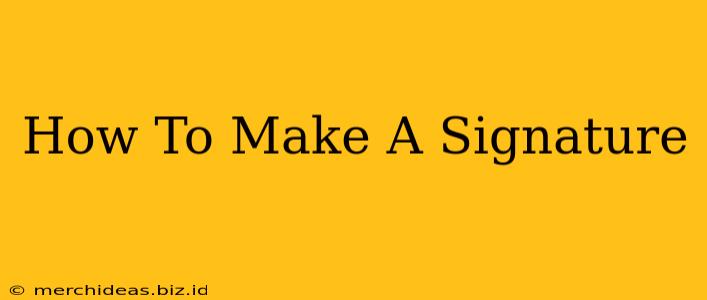Creating a signature might seem simple, but a well-crafted signature is more than just your name scribbled on a document. It's a reflection of your personality and professionalism, a small piece of your personal brand that leaves a lasting impression. Whether it's for professional correspondence, legal documents, or even just personal emails, knowing how to make a signature that's both visually appealing and functionally sound is a valuable skill. This guide will walk you through the process, covering everything from the basics to advanced techniques.
Understanding Your Signature's Purpose
Before diving into the "how-to," consider why you need a signature. Different contexts call for different approaches:
-
Professional Signature: For business emails, contracts, and official documents, your signature should project professionalism and trustworthiness. Think clean lines, a legible font, and potentially the inclusion of your job title and contact information.
-
Personal Signature: For personal letters, cards, or less formal communications, you have more creative freedom. You can incorporate stylistic flourishes, unique lettering, or even a small symbol.
-
Digital Signature: For online forms and emails, you'll likely need a digital image of your handwritten signature or a typed version. Ensuring its clarity and authenticity is crucial.
Creating Your Handwritten Signature
This is the traditional method, and many still prefer the personal touch it provides. Here's a step-by-step guide:
1. Practice Makes Perfect
Start by writing your full name (or preferred version) repeatedly on scrap paper. Experiment with different styles:
- Legibility: Ensure your signature is easily readable. Avoid overly stylized or convoluted script.
- Flow: Aim for a smooth, continuous flow in your strokes.
- Uniqueness: Develop a style that's unique to you, making it easily identifiable as yours.
- Size: Consider the space where your signature will usually appear.
2. Refine Your Style
Once you've experimented with different approaches, choose the style that best represents you and your brand. Consider incorporating subtle flourishes or connecting letters for a more personalized touch.
3. Practice Some More!
Keep practicing your chosen style until you can consistently reproduce it neatly and quickly. Consistency is key for a professional-looking signature.
Creating a Digital Signature
For online use, you'll need a digital version of your signature. Here are a few options:
1. Scanning Your Handwritten Signature
Sign your name on a piece of white paper using black ink. Scan it using a scanner or a smartphone app, ensuring high resolution and a clear, clean background. Crop the image to remove any unnecessary space.
2. Creating a Signature Using Image Editing Software
Software like Adobe Photoshop or GIMP allows for greater control and customization. You can create a completely digital signature, or you can enhance a scanned version.
3. Using Online Signature Generators
Several websites offer free or paid online signature generators. These tools usually allow you to customize fonts, styles, and colors to create a signature that matches your needs.
Incorporating Your Signature
Once you have your signature, you'll need to incorporate it into your documents or emails:
- Handwritten: Use a quality pen and consistent pressure for a professional finish.
- Digital: Insert your digital signature as an image into your email signature or documents. Ensure its size and placement are appropriate.
Including Contact Information in Your Signature
For professional correspondence, including contact details enhances convenience and professionalism. Common inclusions are:
- Full Name
- Job Title
- Company Name
- Phone Number
- Email Address
- Website URL
Protecting Your Signature
Be mindful of the security of your digital signature to prevent forgery or unauthorized use. Avoid sharing high-resolution images of your signature widely.
Creating the perfect signature is a process of refinement. Take your time, experiment with different styles, and ultimately choose a signature that authentically represents you. By following these steps, you can create a signature that is both professional and personally satisfying.
